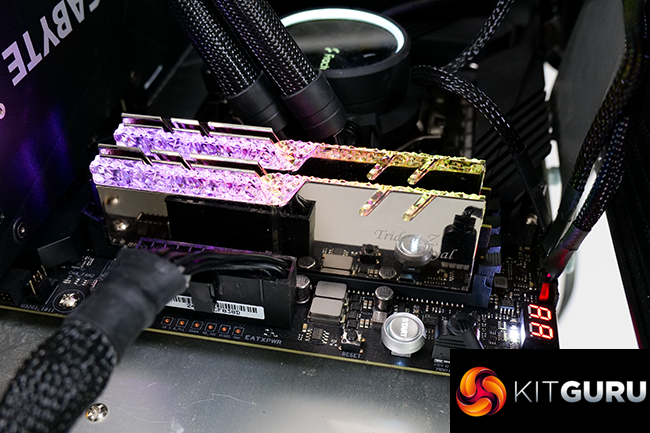We will be outlining the G.SKILL Trident Z Royal DDR4 memory kit's performance with the AMD Ryzen 9 5950X CPU, ASUS ROG Crosshair VIII Hero motherboard, and a Gigabyte RTX 3080 Eagle OC graphics card.
The processor is overclocked to a static 4.6GHz to take any clock speed variability from Precision Boost 2 out of the performance equation.
By default on AMD, 4000MHz memory will deliver a 2000MHz memory clock and therefore a 1000MHz memory controller clock due to the 2:1 divider.
If, however, we can get the Infinity Fabric clock to match the memory clock, we can also run the memory controller clock at the same speed and remove the 2:1 divider latency penalty. Unfortunately, our 5950X doesn’t want to seem to go higher than 1900 MHz for the Fabric Clock.
This means that we have two test procedures:
- We test the kit at stock 4000MHz XMP with the Ryzen system running without adjustment beyond a 4.6GHz CPU OC. This results in 1800MHz Fabric clock, 2000MHz memory clock, and 1000MHz memory controller clock.
- We also test with the memory running alongside a CPU configuration better tuned for high speed memory. This is 1900MHz Fabric clock, 1900MHz memory clock, and 1900MHz memory controller clock. Here, the memory was running at DDR4-3800MHz speeds.
Another minor point is that high-speed memory runs at an even numbered CAS Latency on our AMD test system. As such, the kit runs at CL18 by default under XMP conditions.
Test System:
- Processor: AMD Ryzen 9 5950X overclocked to 4.6GHz all core.
- Motherboard: ASUS ROG Crosshair VIII Hero.
- Graphics Card: Gigabyte RTX 3080 Eagle OC.
- System Drive: WD_Black SN750 SSD.
- CPU Cooler: Fractal Celsius+ S28 Prisma 280mm AIO.
- Power Supply: Seasonic Prime TX-1000 1000W.
- Case: Lian Li Open-air Test Bench.
- Operating System: Windows 10 Pro 64-bit.
Comparison Memory Kits (1:1:1 FCLK:UCLK:MCLK where applicable):
- 2x16GB Corsair Vengeance LPX 3600MHz 16-18-18-36 (Samsung B-Die ICs, dual rank configuration)
- 2x8GB Klevv Bolt XR & Cras XR RGB 4000MHz 18-25-25-45 (Hynix DJR ICs, single rank configuration)
- 2x16GB Patriot Viper Steel RGB 3600MHz 20-26-26-46 (Hynix AFR ICs, dual rank configuration)
- 4x8GB Corsair Dominator Platinum RGB (White) 3600MHz 18-19-19-39 (Micron E-die ICs, effective dual rank configuration)
- 2x32GB Patriot Viper Steel 3600MHz 18-22-22-42 (SpecTek MT40 ICs, dual rank configuration)
- 2x16GB Corsair Vengeance RGB Pro SL 3600MHz 18-22-22-42 (Micron D9XPF B-die ICs, single rank configuration)
Tests:
- 7-Zip – Built-in 7-Zip benchmark test (CPU & Memory)
- Cinebench R20 – All-core & single-core CPU benchmark (CPU & Memory)
- Blender 2.90 – All-core rendering of the Classroom benchmark (CPU & Memory)
- SiSoft Sandra – Memory bandwidth (Memory)
- AIDA64 – Memory bandwidth, memory latency (Memory)
- 3DMark TimeSpy – Time Spy (1440p) test (Gaming)
- Shadow of the Tomb Raider – 1920 x 1080, Highest quality preset, no AA, DX12 version (Gaming)
 KitGuru KitGuru.net – Tech News | Hardware News | Hardware Reviews | IOS | Mobile | Gaming | Graphics Cards
KitGuru KitGuru.net – Tech News | Hardware News | Hardware Reviews | IOS | Mobile | Gaming | Graphics Cards





